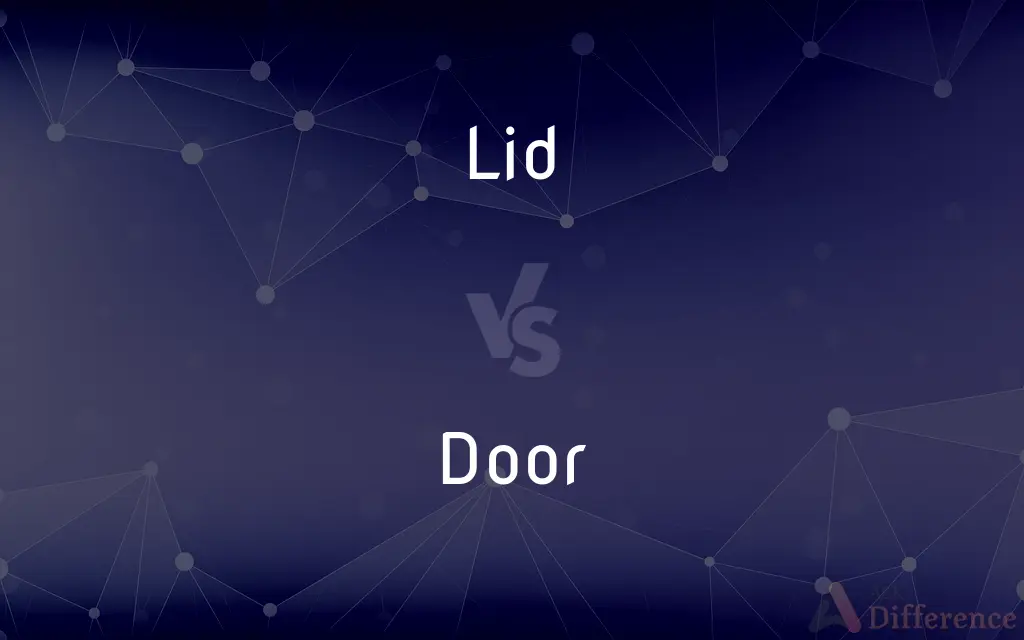Lid vs. Door — What's the Difference?
By Maham Liaqat & Fiza Rafique — Updated on March 29, 2024
A lid covers the opening of a container to protect or seal its contents, while a door provides access to an enclosed space, allowing entry or exit.

Difference Between Lid and Door
Table of Contents
ADVERTISEMENT
Key Differences
A lid is designed primarily to fit atop or over the opening of a container, such as a pot, box, or jar, with the purpose of securing its contents, preserving freshness, or preventing spills. In contrast, a door functions as a movable barrier installed in a doorway, facilitating the passage of people, animals, or goods between different areas or rooms.
While lids are often associated with containers that hold substances or small items (e.g., food, liquids, or treasures), doors are integral to the structure of buildings, vehicles, and large furniture, emphasizing their role in controlling access and ensuring privacy or security. Lids can be simple and manually operated, requiring one to lift or remove them to access the contents, whereas doors, besides being manual, can also incorporate advanced features like locks, automated systems, and security devices.
The concept of a lid involves a direct physical contact sealing mechanism, often creating an airtight or watertight closure to preserve the container's contents from external elements. On the other hand, doors, while they can seal an entryway, are more focused on allowing or restricting access, with their design accommodating locks, screens, or even windows to balance between security, visibility, and ventilation.
In terms of construction, lids are usually made to match the material and shape of their corresponding containers, ensuring a snug fit, while doors are constructed to withstand frequent use, potentially harsh weather conditions, and to provide an aesthetic appeal to the entrances they guard.
Despite their differences, both lids and doors serve essential protective functions—lids guard against the direct contamination or loss of contents, and doors protect against unauthorized entry or exposure to external environments, highlighting their respective roles in safeguarding and accessibility.
ADVERTISEMENT
Comparison Chart
Primary Function
Covers containers
Provides access to spaces
Associated With
Containers (jars, pots, boxes)
Buildings, rooms, vehicles
Operation
Removal or opening for access
Swinging, sliding for entry/exit
Design Focus
Sealing, preserving contents
Access control, privacy, security
Features
May be airtight, snap-on
Locks, handles, automated systems
Material Matching
Matches container
Varied, often for durability/style
Protection Against
Spills, contamination, spoilage
Unauthorized entry, environmental elements
Use Frequency
Often used in storage, cooking
Daily use in buildings, vehicles
Compare with Definitions
Lid
Cover for containers.
She closed the jar tightly with its lid to keep the cookies fresh.
Door
Access to spaces.
She opened the door to let the guests into the house.
Lid
Material compatibility.
The wooden lid complemented the bamboo rice steamer's natural look.
Door
Ensures privacy.
Closing the bedroom door, he ensured his conversation remained private.
Lid
Protects contents.
The pot's lid prevented the water from spilling over while boiling.
Door
Variety in operation.
The sliding doors made accessing the patio a breeze.
Lid
Simple operation.
He lifted the lid to add ingredients to the stew.
Door
Aesthetic and functional.
The ornate door added to the historic building's charm while providing security.
Lid
Can be airtight.
The airtight lid on the container kept the coffee beans fresh for weeks.
Door
Incorporates security features.
The front door was equipped with a new, high-security lock.
Lid
A lid, also known as a cover, is part of a container, and serves as the closure or seal, usually one that completely closes the object. Lids can be placed on small containers such as tubs as well as larger lids for open-head pails and drums.
Door
A door is a hinged or otherwise movable barrier that allows ingress into and egress from an enclosure. The created opening in the wall is a doorway or portal.
Lid
A removable or hinged cover for the top of a container
A dustbin lid
Door
A hinged, sliding, or revolving barrier at the entrance to a building, room, or vehicle, or in the framework of a cupboard
She looked for her key and opened the door
That audition was the door to all my future successes
Lid
A removable or hinged cover for a hollow receptacle or box.
Door
A movable structure used to close off an entrance, typically consisting of a panel that swings on hinges or that slides or rotates.
Lid
An eyelid.
Door
A similar part on a piece of furniture or a vehicle.
Lid
(Biology) A flaplike covering, such as an operculum.
Door
A doorway.
Lid
A curb, restraint, or limit
Approved a new lid on corporate spending.
Door
The room or building to which a door belongs:They live three doors down the hall.
Lid
(Informal) An act of concealment; a cover
Told us to keep a lid on the report until the campaign was over.
Door
A means of approach or access:looking for the door to success.
Lid
(Slang) A hat.
Door
(Slang)To strike (a passing bicyclist, for example) by suddenly opening a vehicular door.
Lid
(Slang) An ounce of marijuana.
Door
To serve as a doorman or doorwoman of (a nightclub, for example).
Lid
The top or cover of a container.
Door
A portal of entry into a building, room, or vehicle, typically consisting of a rigid plane movable on a hinge. Doors are frequently made of wood or metal. May have a handle to help open and close, a latch to hold the door closed, and a lock that ensures the door cannot be opened without the key.
I knocked on the vice president's door
Lid
(slang) A cap or hat.
Door
Any flap, etc. that opens like a door.
The 24 doors in an Advent calendar
Lid
(slang) One ounce of cannabis.
Door
(immigration) An entry point.
Lid
A bodyboard or bodyboarder.
Door
(figurative) A means of approach or access.
Learning is the door to wisdom.
Lid
(slang) A motorcyclist's crash helmet.
Door
(figurative) A possibility.
To leave the door open
All doors are open to somebody
Lid
(slang) In amateur radio, an incompetent operator.
Door
(figurative) A barrier.
Keep a door on your anger.
Lid
Clipping of eyelid
Door
A software mechanism by which a user can interact with a program running remotely on a bulletin board system. See BBS door.
Lid
(microelectronics) A hermetically sealed top piece on a microchip such as the integrated heat spreader on a CPU.
Door
The proceeds from entrance fees and/or ticket sales at a venue such as a bar or nightclub, especially in relation to portion paid to the entertainers. "The bar owner gives each band a percentage of the door and charges customers more to get in"
Lid
(figurative) A restraint or control, as when "putting a lid" on something.
Door
To cause a collision by opening the door of a vehicle in front of an oncoming cyclist or pedestrian.
Lid
(Scouse) A kid (from the rhyming slang bin lid)
Door
An opening in the wall of a house or of an apartment, by which to go in and out; an entrance way.
To the same end, men several paths may tread,As many doors into one temple lead.
Lid
(transitive) To put a lid on (something).
Door
The frame or barrier of boards, or other material, usually turning on hinges, by which an entrance way into a house or apartment is closed and opened.
At last he came unto an iron doorThat fast was locked.
Lid
That which covers the opening of a vessel or box, etc.; a movable cover; as, the lid of a chest or trunk.
Door
Passage; means of approach or access.
I am the door; by me if any man enter in, he shall be saved.
Lid
The cover of the eye; an eyelid.
Tears, big tears, gushed from the rough soldier's lid.
Door
An entrance way, but taken in the sense of the house or apartment to which it leads.
Martin's office is now the second door in the street.
A riot unpunished is but next door to a tumult.
His imaginary title of fatherhood is out of doors.
If I have failed, the fault lies wholly at my door.
Lid
The cover of the spore cases of mosses.
Door
A swinging or sliding barrier that will close the entrance to a room or building or vehicle;
He knocked on the door
He slammed the door as he left
Lid
Either of two folds of skin that can be moved to cover or open the eye;
His lids would stay open no longer
Door
The entrance (the space in a wall) through which you enter or leave a room or building; the space that a door can close;
He stuck his head in the doorway
Lid
A movable top or cover (hinged or separate) for closing the opening of a container
Door
Anything providing a means of access (or escape);
We closed the door to Haitian immigrants
Education is the door to success
Lid
Headdress that protects the head from bad weather; has shaped crown and usually a brim
Door
A structure where people live or work (usually ordered along a street or road);
The office next door
They live two doors up the street from us
Door
A room that is entered via a door;
His office is the third door down the hall on the left
Common Curiosities
Can a lid be considered a type of door?
While both serve to cover openings, lids are specifically for containers, making them distinct from doors.
What is the primary purpose of a lid?
The primary purpose of a lid is to cover the opening of a container to protect its contents.
What materials are doors made from?
Doors can be made from wood, metal, glass, plastic, or composite materials, depending on their intended use and design preferences.
How do lids contribute to food preservation?
Lids can create an airtight seal, preventing air, moisture, and contaminants from affecting the food's quality.
How do door designs vary?
Door designs vary widely, from simple, functional styles to elaborate, decorative ones, often reflecting architectural styles.
Is it easy to replace a lid or door?
While lids can often be easily replaced if they match the container size, replacing doors may require more effort and customization.
Are all doors designed to lock?
Not all doors have locks, but many, especially those for exterior access or privacy, include locking mechanisms.
What role do lids play in cooking?
In cooking, lids help retain heat and moisture in pots and pans, speeding up the cooking process and enhancing flavor.
How does a door function?
A door functions as a movable barrier that allows or restricts access to an enclosed space.
Can a door serve as a design element in a room?
Yes, doors often contribute significantly to a room's aesthetic, with choices in color, material, and design enhancing interior themes.
What are some common types of lids?
Common types of lids include screw-on, snap-on, and flip-top lids, each designed for specific container types.
Can both lids and doors be automated?
Automation is more common with doors (e.g., garage doors, automatic sliding doors) but can apply to certain industrial container lids.
Are there environmental considerations with door and lid materials?
Yes, the sustainability of materials used in doors and lids, such as recyclability and energy efficiency, can impact environmental footprint.
How does one maintain a door?
Maintaining a door involves regular cleaning, checking and tightening hardware, and ensuring the locking mechanisms function properly.
Do lids and doors require different types of care?
Yes, lids often need cleaning specific to their container's contents, while doors may require maintenance for hinges, locks, and weatherproofing.
Share Your Discovery

Previous Comparison
Hoax vs. Prank
Next Comparison
Port vs. MuscatAuthor Spotlight
Written by
Maham LiaqatCo-written by
Fiza RafiqueFiza Rafique is a skilled content writer at AskDifference.com, where she meticulously refines and enhances written pieces. Drawing from her vast editorial expertise, Fiza ensures clarity, accuracy, and precision in every article. Passionate about language, she continually seeks to elevate the quality of content for readers worldwide.














































